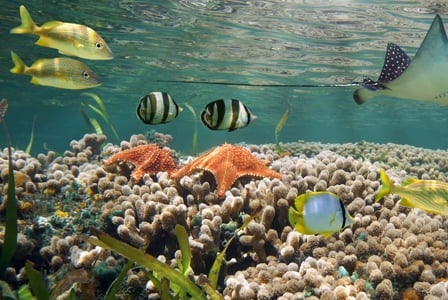
Corals – the tiny animals with a big impact. Learn about them on this Wildlife Wednesday!
With World Oceans Day taking place this Sunday, we’re exploring the deep blue sea! On this Wildlife Wednesday, take a deep breath and plunge into a wealth of trivia about coral—and learn why they’re so important to land lubbers and sea dwellers alike.
Habitat
Coral reefs can be found off the coasts of more than 100 countries. Depending on the species, reefs can be found in cold or warm waters ranging anywhere from less than 60 ft (18 m) to more than 9,800 ft (3,000 m) deep!
Trivia
- Although hard members of the coral species tend to look a lot like rocks and softer corals can be mistaken for plants, the corals we see are actually colonies of tiny animals called “polyps.”
- Fortunately for us, corals are quite a bit less painful than their closest relatives, jellyfish and anemones. However, that still doesn’t mean that we should disturb them, since these sturdy looking creatures are actually quite fragile!
- Polyps are clear, even though the corals and reefs we know about come in all sorts of colours. Their vibrant hues actually come from microscopic algae that live within each polyp.
- Beyond making corals a somber purple or vivid red, these algae also provide corals with up to 90 percent of the nutrients the polyps need. Corals get the other 10 percent by capturing live prey.
- Although coral reefs cover less than one-tenth of the ocean floor, they provide homes for more than 25 percent of the world\’s marine wildlife, making them important to the environment and our dinner plates.
Why so blue?
According to the IUCN Red List, coral species can range from “least concern” to “critically endangered.” However, researchers agree that corals are facing a stormy future, as more than a quarter of the world’s reefs already damaged beyond repair and another two-thirds are considered to be under serious threat.
Climate change is one major concern, as it contributes to ocean acidification (when CO2 absorbed by the ocean increases its acidity levels), coral bleaching (when corals that become too warm reject the algae that provide them with nutrients), an increase in storms, and other issues.
Unsustainable fishing practices, such as overfishing and destructive methods of fishing, can seriously harm reefs and affect the ecological balance of underwater communities. Pollution, unsustainable tourism, and coral mining can are also threats.
However, if we can help out our polyp-pals by keeping our oceans clean and reducing our carbon footprint, calmer seas may be in sight. Researchers are working on several different ways to protect and restore reefs, and some are suggesting that corals may be able to adapt to the ocean’s changes.


